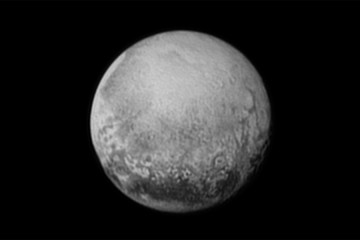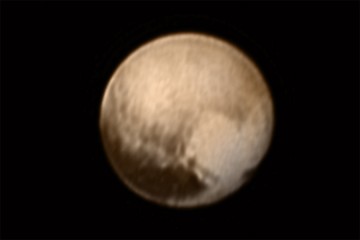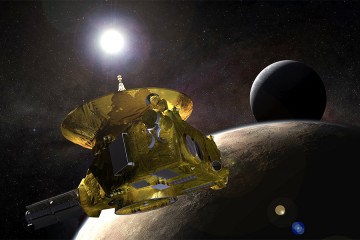NASA's New Horizons mission has answered one of the most basic questions about Pluto—how big is it?
Mission scientists have found Pluto to be 1,473 miles in diameter, somewhat larger than many prior estimates. Images acquired with the spacecraft's Long Range Reconnaissance Imager, or LORRI, were used to make this determination, confirming what was already suspected: Pluto is larger than all other known solar system objects beyond the orbit of Neptune.
"The size of Pluto has been debated since its discovery in 1930," said mission scientist Bill McKinnon of Washington University in St. Louis. "We are excited to finally lay this question to rest."
Pluto's newly estimated size means that its density is slightly lower than previously thought, and the fraction of ice in its interior is slightly higher. Also, the lowest layer of Pluto's atmosphere, called the troposphere, is shallower than previously believed.
Measuring Pluto's size has been a decades-long challenge due to complicating factors from its atmosphere. Its largest moon, Charon, lacks a substantial atmosphere, and its diameter was easier to determine using ground-based telescopes. New Horizons observations of Charon confirm previous estimates of 751 miles across, about half the size of Pluto.
By comparison, Earth has a diameter of 7,918 miles, making it more than five times the size of Pluto. Jupiter is by far the solar system's largest planet with a diameter of 86,881 miles.
#PlutoFacts: Pluto would fit comfortably between New York & Dallas. Between Rome & Moscow. Between Perth & Melbourne.
— Neil deGrasse Tyson (@neiltyson) July 12, 2015LORRI has also zoomed in on two of Pluto's smaller moons, Nix and Hydra.
"We knew from the time we designed our flyby that we would only be able to study the small moons in detail for just a few days before closest approach," said principal investigator Alan Stern of the Southwest Research Institute in Boulder, Colorado. "Now, deep inside Pluto's sphere of influence, that time has come."
Nix and Hydra were discovered using the Hubble Space Telescope in 2005. Even to Hubble, they appeared as points of light, and that's how they looked to New Horizons until the final week of its approach to Pluto. Now, the latest LORRI images show the two diminutive satellites not as pinpoints, but as moons seen well enough to measure their sizes. Nix is estimated to be about 20 miles across, while Hydra is roughly 30 miles across. These sizes lead mission scientists to conclude that their surfaces are quite bright, possibly due to the presence of ice.
What about Pluto's two smallest moons, Kerberos and Styx? Smaller and fainter than Nix and Hydra, they are harder to measure. Mission scientists should be able to determine their sizes with observations New Horizons will make during the flyby and will transmit to Earth at a later date.
Posted in Science+Technology
Tagged applied physics laboratory, space exploration, nasa, new horizons












